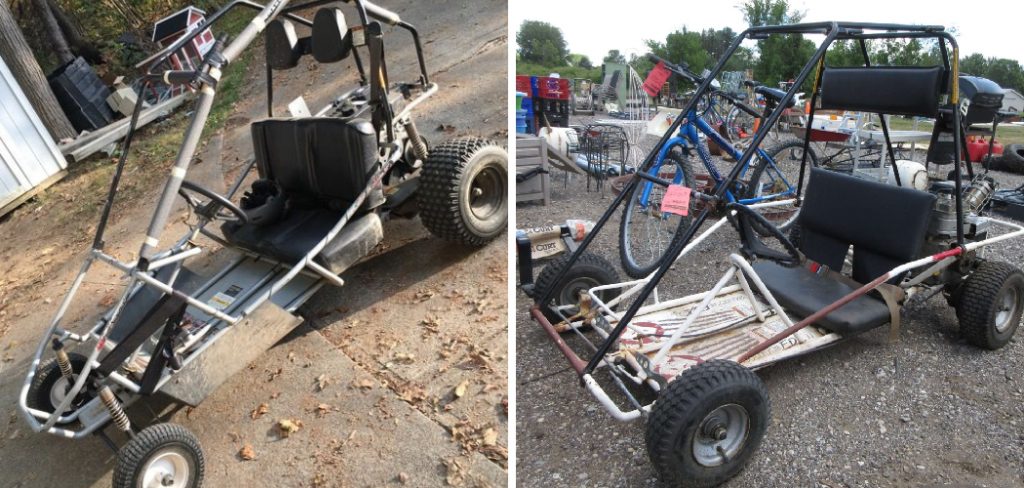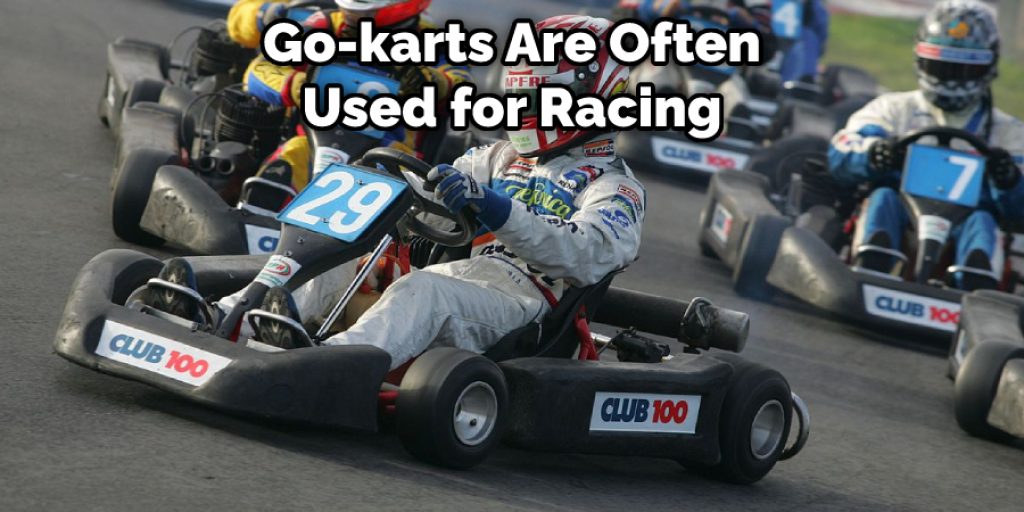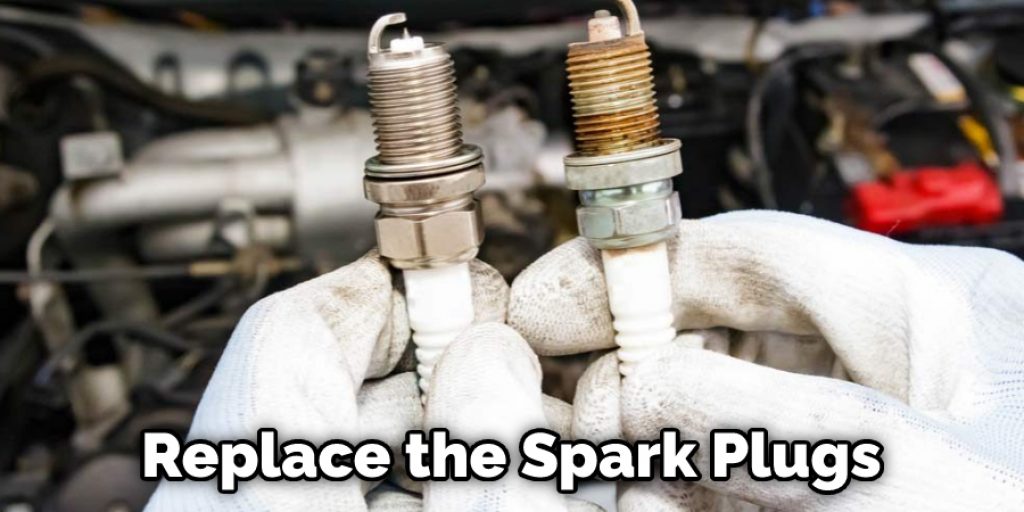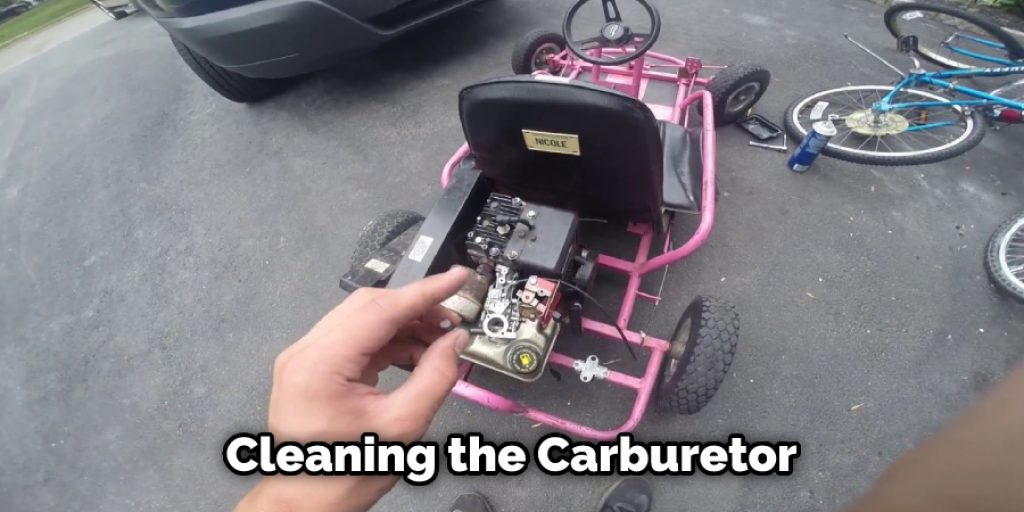If you’re a go-kart enthusiast, you’ve experienced the frustration of a broken go-kart. Luckily, there are many ways to fix a go-kart, and in this blog post, we’ll explore some of the most common repairs.

Whether your go-kart is experiencing problems with the engine, the suspension, or something else, we’ll show you how to get it back up and running in no time! So keep reading for tips on how to fix a go kart – regardless of what’s gone wrong.
Summary: If your go kart is not running right, there are a few things you can do to fix it. First, check the oil level. If it’s low, add more oil to the motor. Next, make sure the spark plugs are installed properly. Finally, check the chain and sprockets for wear or damage.
What Is a Go-Kart?
A kart is a small vehicle that is powered by a motor. It has four wheels and is usually designed for racing. However, it can also be used for recreational purposes. A kart typically has an open cockpit, which allows the driver to be seated in a low position. This gives the driver better control over the kart and helps to reduce wind resistance.
Go-karts are small, fast cars that can be powered by gasoline or electricity. They can reach speeds of up to 60 miles per hour. Some go-karts also have a roll cage, which helps protect the driver in case of a crash.
Why Should You Fix a Go-Kart?
A go-kart is a small, lightweight vehicle with four wheels and a steering wheel. Gasoline engines typically power go-karts, but some models may be electric.
No matter how you use your go-kart, it’s important to keep it in good working condition. Regular maintenance and repairs will extend the life of your go-kart and ensure that it runs properly.

Go-karts are relatively simple vehicles, so that most repairs can be made with basic tools and supplies. In addition, many go-kart parts are readily available and relatively inexpensive. As a result, there’s no excuse for not keeping your go-kart in top condition!
How to Fix a Go Kart Step by Step Guide
Step 1: Identify the Issue
Begin by identifying the specific issue with your go-kart. Common problems include engine issues, steering problems, braking issues, and drivetrain malfunctions. Once you have identified the issue, gather the necessary tools and replacement parts to address the problem.
Step 2: Safety Precautions
Before working on your go-kart, ensure that it is turned off and properly secured to prevent any accidental movement. Disconnect the spark plug to prevent the engine from starting while you are working on it. Always wear appropriate safety gear, such as gloves and eye protection, while working on your go-kart.
Step 3: Engine Troubleshooting and Repair
If your go-kart is experiencing engine issues, such as not starting, lack of power, or stalling, follow these steps:
- Check the fuel system: Ensure that there is fresh, uncontaminated fuel in the tank and that the fuel lines are not clogged or damaged. Replace the fuel filter if necessary.
- Inspect the air filter: Clean or replace the air filter if it is dirty or clogged.
- Check the spark plug: Inspect the spark plug for signs of wear or damage and replace it if necessary. Ensure that the spark plug gap is set to the manufacturer’s specifications.
- Inspect the carburetor: Clean the carburetor and adjust it according to the manufacturer’s recommendations. Replace the carburetor if it is damaged or excessively worn.
- Examine the ignition system: Test the ignition coil, CDI (capacitor discharge ignition) box, and stator for proper function, and replace any faulty components.
Step 4: Steering System Repair
If your go-kart has steering issues, such as difficulty turning or loose steering, follow these steps:
- Inspect the tie rods: Check for any bent or damaged tie rods and replace them if necessary.
- Examine the steering shaft: Ensure that the steering shaft is securely fastened and not bent or damaged. Replace the steering shaft if it is faulty.
- Check the steering wheel: Tighten the steering wheel if it is loose or replace it if it is damaged or excessively worn.
- Lubricate the steering components: Apply grease to the steering shaft, tie rod ends, and other moving parts to ensure smooth operation.
Step 5: Brake System Repair
If your go-kart has braking issues, such as reduced stopping power or brake failure, follow these steps:
- Inspect the brake pads: Check the brake pads for wear and replace them if they are worn or damaged.
- Examine the brake calipers: Ensure that the brake calipers are functioning properly and not sticking or leaking. Replace any faulty calipers.
- Check the brake lines: Inspect the brake lines for leaks or damage and replace them if necessary.
- Bleed the brakes: If your go-kart has hydraulic brakes, bleed the brake system to remove any air bubbles and ensure proper brake function.
Step 6: Drivetrain Repair
If your go-kart has drivetrain issues, such as loss of power, difficulty accelerating, or chain slippage, follow these steps:
- Inspect the chain: Check the chain for proper tension and alignment, and adjust it if necessary. Replace the chain if it is worn or damaged.
- Examine the sprockets: Inspect the sprockets for wear or damage and replace them if necessary.
- Check the clutch: Ensure that the clutch is functioning properly and not slipping or sticking. Replace the clutch if it is worn or damaged.
- Inspect the torque converter or gearbox: Examine the torque converter or gearbox for any signs of wear or damage and replace any faulty components.
Step 7: Tire and Wheel Inspection
Check the tires for proper inflation, wear, or damage, and replace them if necessary. Ensure that the wheels are securely fastened and not bent or damaged. If your go-kart has a suspension system, inspect it for proper function and replace any worn or damaged components.
Step 8: Electrical System Repair
If your go-kart has electrical issues, such as non-functioning lights or a dead battery, follow these steps:
- Check the battery: Test the battery to ensure it is holding a charge and replace it if necessary. Ensure that the battery connections are clean and secure.
- Inspect the wiring: Examine the wiring for any signs of damage or corrosion, and repair or replace any damaged wiring.
- Test the lights: Ensure that all lights are functioning properly and replace any burnt-out bulbs or damaged light fixtures.
- Examine the switches and fuses: Check the switches for proper function and replace any blown fuses.
Step 9: Frame and Body Repair
Inspect the go-kart frame for any signs of damage, such as cracks, bends, or rust. Repair any damaged areas by welding or using appropriate reinforcement methods. Check the body panels, seats, and other components for damage and replace them if necessary.
Step 10: Perform Routine Maintenance
Perform routine maintenance on your go-kart, such as changing the oil, cleaning the air filter, and lubricating moving parts. Regular maintenance will help to prolong the life of your go-kart and ensure optimal performance.
Step 11: Test Drive and Adjustment
Once you have completed the necessary repairs, take your go-kart for a test drive to ensure that it is functioning properly. Make any necessary adjustments to the steering, brakes, or drivetrain as needed to optimize performance and handling.
Step 12: Keep a Maintenance Log
Document the repairs and maintenance performed on your go-kart in a maintenance log. This will help you keep track of when certain tasks need to be completed and provide a record of the work done on your go-kart.
Step 13: Educate Yourself on Go-Kart Maintenance and Repair
Learn more about go-kart maintenance and repair to better understand how to diagnose and fix issues that may arise. Familiarize yourself with the specific components and systems of your go-kart, as different models may have unique features or requirements.
Step 14: Consult a Professional if Necessary
If you encounter a problem that you are unable to diagnose or repair, consult a professional mechanic or go-kart repair expert. They can provide guidance and assistance to ensure that the repair is done correctly and safely.
By following these steps and regularly maintaining your go-kart, you can ensure that it remains in optimal condition and provides you with many hours of enjoyment. Keep in mind that safety should always be a top priority when working on and operating your go-kart, so always use caution and follow the manufacturer’s recommendations.
How to Fix a Go-Kart That Won’t Stay Running
1. Contaminated or Improper Fuel
If your go-kart stalls after running for a little while, it may be caused by contaminated or improper fuel. The fuel might have water in it, which can cause the engine to stall. Drain the gas tank and fill it with fresh gasoline to fix this problem.
2. Clogged Air Filter
The air filter keeps dirt and other particles from getting into the engine, so it’s important to check it regularly and clean or replace it. A clogged air filter will restrict the airflow to the engine, making it run leaner and therefore hotter. This can lead to engine damage.
3. Spark Plug Issues
A common issue with go-karts is that the spark plugs are not firing correctly. This problem is often caused by a loose connection, dirty spark plugs, or a problem with the ignition system. To fix this problem, start by checking the spark plugs and cleaning them if necessary. If the problem persists, it may be necessary to replace the spark plugs.

4. Damaged or Clogged Carburetor
One of the most common reasons a go-kart won’t stay running is because the carburetor is damaged or clogged. If the carburetor is damaged, it will need to be replaced. If it is clogged, you will need to clean it out with carburetor cleaner.
5. Engine Issues
The most common reasons a go-kart won’t stay running are engine-related. If your go-kart has an issue with the engine, it will likely struggle to stay running or have trouble starting in the first place
Engine problems can be caused by several things, including a loose connection, low oil levels, or a damaged engine part. If you suspect your go-kart has an engine issue, take it to a mechanic for diagnosis and repair.
If your go-kart doesn’t stay running, there are some potential causes. The most common reasons are related to the fuel, air filter, spark plugs, carburetor, or engine. By troubleshooting each of these areas, you should be able to identify and fix the problem. If you want to know more about how to fix a go kart, Keep reading.
Why Is My Go-Kart Bogging Down?
Go-karts are exciting, fast machines. But when your go-kart starts bogging down, it can be frustrating. There are a few reasons why this might happen. The first is that the air filter might be dirty. This restricts the airflow to the engine and can cause the engine to bog down.
Another possibility is that the fuel mixture is too rich. This means too much fuel in the mixture and not enough air. This can also lead to engine bogging.

Lastly, the problem could be with the spark plugs. If they are dirty or damaged, they might not be firing correctly, and this will cause engine bogging. If your go-kart is bogging down, check these three things first.
Why Is My Go-Kart Backfiring?
There are a few reasons why your go-kart might be backfiring. One possibility is that the fuel mixture is too rich, meaning there is too much fuel and not enough air. This can happen if the carburetor is not adjusted properly or if the air filter is dirty.
Another possibility is that the spark plugs are fouled or damaged. This can be caused by various factors, including extended idling, operating in dusty or dirty conditions, or using lower-quality fuel. Check the fuel mixture and spark plugs first if your go-kart is backfiring. These are relatively easy to fix and are often the cause of backfiring.
However, if these don’t remedy the problem, it’s best to take your go-kart to a mechanic for further diagnosis.
Frequently Asked Question
Can a Go-Kart Overheat?
Just like any other engine, a go-kart engine can overheat if it is not properly cooled. Most go-karts have an air-cooled engine, which means it uses air to help keep the engine cool. However, if the engine is worked too hard or has blocked airflow, the engine can overheat.
Why Does My Engine only Run on Choke?
If your engine only runs on choke, it’s likely that the carburetor is dirty and needs to be cleaned. Over time, fuel can evaporate from the carburetor bowl, leaving behind a sticky residue. This residue can build up and clog the tiny jets and passages in the carburetor, making it difficult for the engine to get its fuel.
Cleaning the carburetor is a pretty simple process, and there are plenty of how-to videos and tutorials online that can walk you through the steps. Once you’ve cleaned the carburetor, your engine should run much more smoothly.

Why Is My Go-Kart Clutch Smoking?
If you’re experiencing clutch smoking on your go-kart, there are some potential causes. One common reason is that the clutch is not disengaging properly, which can be caused by various factors such as a sticking clutch plate or worn-out bearings. If the clutch isn’t disengaging properly, it will continue to spin and generate heat, which can cause the clutch to smoke.
Another potential cause of clutch smoking is that the go-kart is overloaded. If the go-kart is carrying too much weight or pulling a heavy load, the clutch will have to work harder and generate more heat. This can also cause the clutch to smoke.
Conclusion
So, there you have it. Now that you know how to fix a go kart, you can get back out on the track and start winning races again. Just be sure to follow our tips for keeping your kart in good condition, and you’ll be able to enjoy those speedy laps for years to come. Have fun!
You May Also Read: How to Fix a Leaking Brake Bleed Valve
